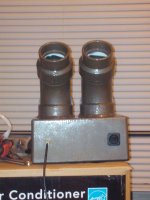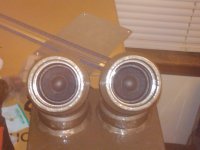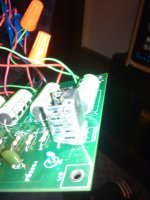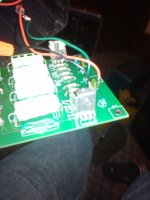I dont know if anybody is interested but recently I built a set of powered stereo speakers for my android phone and the design worked out well imho. Basically the project started because I am no longer comfortable using headphones anymore after becoming aware of how damaging they are to your hearing. I was willing to buy something but I wanted something that didnt sound like crap and light enough to actually take with me camping and hiking on occasion. Most of the commercial choices are either really bad or really expensive.
This was a budget build and I wasn't expecting much. I knew I wanted to keep it small so from the beginning I accepted there was going to be no real bass.The LM1875 was picked by chance because I saw positive reviews quickly after searching for low wattage audio opamps plus the model was already included in Multisim.
I designed the circuit for the output of my phone which is 0.5v max output and it works great from 10%-100% volume also tested it with an ipod touch with similar results. My computer output is like 1v max output so it starts to clip at 70% volume and up when the batteries run down.
I chose Aurasound NS2-143-16B 2" Full Range 16 ohm speakers because the high impedance load keeps the current low so battery life is longer. It also gives extra headroom with the higher output sources like pc.
I know the 1000uf caps may sound big and there is no ac in the power source to decouple but it solved a different issue I had with the batteries draining unequally. The original design had 100uf and I went right to 1000uf so there might be a happy medium in there somewhere but I used 16v axial electrolytic caps that are not too large anyway. The zobel caps were 35V tantalum because thats what I had on hand. The 1ohm was 1/2 watt. the input cap was added to remove distortion from the speakers. A 0.47uf 35V tantalum won out listening test over many different ceramic, mylar, and tantalum caps.
In the end I was impressed with the sound enough that I am building a full power amp for home.
This was a budget build and I wasn't expecting much. I knew I wanted to keep it small so from the beginning I accepted there was going to be no real bass.The LM1875 was picked by chance because I saw positive reviews quickly after searching for low wattage audio opamps plus the model was already included in Multisim.
I designed the circuit for the output of my phone which is 0.5v max output and it works great from 10%-100% volume also tested it with an ipod touch with similar results. My computer output is like 1v max output so it starts to clip at 70% volume and up when the batteries run down.
I chose Aurasound NS2-143-16B 2" Full Range 16 ohm speakers because the high impedance load keeps the current low so battery life is longer. It also gives extra headroom with the higher output sources like pc.
I know the 1000uf caps may sound big and there is no ac in the power source to decouple but it solved a different issue I had with the batteries draining unequally. The original design had 100uf and I went right to 1000uf so there might be a happy medium in there somewhere but I used 16v axial electrolytic caps that are not too large anyway. The zobel caps were 35V tantalum because thats what I had on hand. The 1ohm was 1/2 watt. the input cap was added to remove distortion from the speakers. A 0.47uf 35V tantalum won out listening test over many different ceramic, mylar, and tantalum caps.
In the end I was impressed with the sound enough that I am building a full power amp for home.
Attachments
Your other thread about heatsinks reminded me I am using just the standard aluminum to220 clip on heatsink. It gets warm to the touch but I can leave my finger on it and not get burned. I'll post picks of the board later although my pcb layout could be improved on. it was too spread out. and square is a horrible idea for a pcb shape lesson learned. I also build the voltage divider on the switch because the bigger caps I switched in.
Member
Joined 2009
Paid Member
How much output power do you reckon that can do? Those seem like such small heatsinks! Maybe I over estimate the heat of these chips. I had an old Logitech chipamp that I took apart and those things would get SCORCHING HOT even attached to a big heatsink, and they only did 7.5W each MAX. It was ridiculous.
How much output power do you reckon that can do? Those seem like such small heatsinks! Maybe I over estimate the heat of these chips. I had an old Logitech chipamp that I took apart and those things would get SCORCHING HOT even attached to a big heatsink, and they only did 7.5W each MAX. It was ridiculous.
7.2v max out so about 3w at full blast per chip. Its a 25w max chip so I am not working it too hard. I did test it full power for 2 hours then touched and like I said it felt hot but I can leave my finger on it without being forced to pull away.
Last edited:
ya you need 2 batteries to get a negative rail. 3 hours is with 440mah batteries but it doesnt die at 3 hours just thats the point I start to lose low end. its closer to 4 hours till it starts to clip.Whoa 2 9Vs? That's crazy. 3 Hours isn't half bad.
Last edited:
I never said it was the best design or best chip but it works just fine. Batteries last long enough for a day at the beach or night by a fire and it sounds good.These ClassAB National chipamps are not designed specifically for battery powering.
They draw a high Iq that drains the batteries too quickly even when not reproducing audio signals.
These 5 pin power amp chips are fun and versatile. I have a TDA2050 running with 3 volts (+/- 1.5 volt rails). The bias seems to come on at around 2.5 volts and the output is only a few miliwatts but is crystal clear if I keep it out of clipping (yeah, not really practical, I know). If I got it off the breadboard and into a circuit, I'd build it to handle full power dissipation so I could use it at 40 volts for full power or 6 volts if I wanted something battery powered in a pinch.
For the OP, I'd use a +/- 6 volt rails with AA or C cells and 4 or 8 Ohm loads. this will help mitigate the quiescent current draw issue while keeping the power out about the same yet give you much longer run times.
BTW, what is the low voltage shutdown point for the LM1875 anyway? The TDA2050, 2040 seem to operate at very low voltages.
For the OP, I'd use a +/- 6 volt rails with AA or C cells and 4 or 8 Ohm loads. this will help mitigate the quiescent current draw issue while keeping the power out about the same yet give you much longer run times.
BTW, what is the low voltage shutdown point for the LM1875 anyway? The TDA2050, 2040 seem to operate at very low voltages.
Last edited:
ya you need 2 batteries to get a negative rail. 3 hours is with 440mah batteries but it doesnt die at 3 hours just thats the point I start to lose low end. its closer to 4 hours till it starts to clip.
They don't get insanely hot? They must...
- Status
- This old topic is closed. If you want to reopen this topic, contact a moderator using the "Report Post" button.
- Home
- Amplifiers
- Chip Amps
- My portable LM1875



